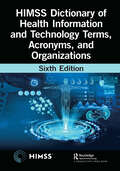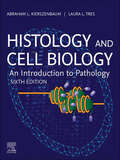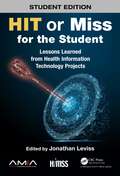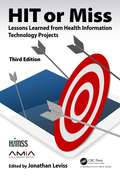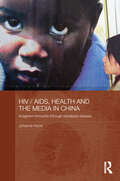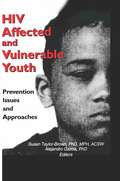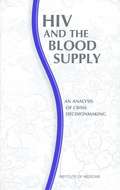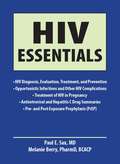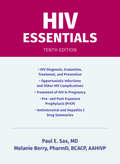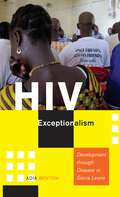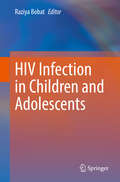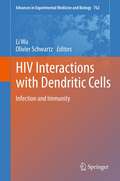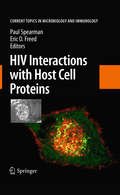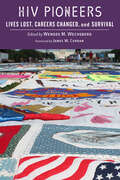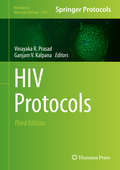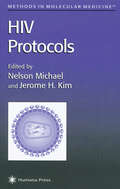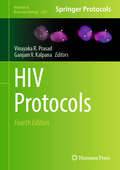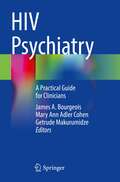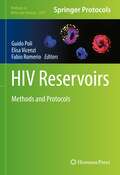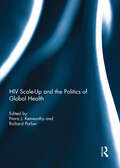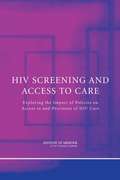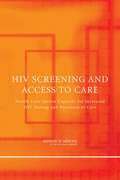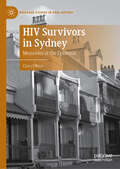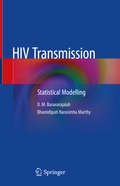- Table View
- List View
HIMSS Dictionary of Health Information and Technology Terms, Acronyms, and Organizations (HIMSS Book Series)
by Healthcare Information & Management Systems Society (HIMSS)This significantly expanded and newest edition of the bestselling HIMSS Dictionary of Health Information Technology Terms, Acronyms, and Organizations has been developed and extensively reviewed by more than 50 industry experts. The sixth edition of this dictionary serves as a quick reference for students, health information technology professionals, and healthcare executives to better navigate the ever-growing health IT field and includes new terms used as a result of the COVID-19 pandemic and will serve as a resource for HIMSS’ new certification based on digital health transformation as well as for those taking the CPHIMS and CAHIMS certification exams. This valuable resource includes more than 3,000 definitions, 30 organizations, and numerous new references. Definitions of terms for the information technology and clinical, medical, and nursing informatics fields are updated and included. This sixth edition also includes an acronym list with cross-references to current definitions, new word-search capability, and a list of health IT-related associations and organizations, including contact information, mission statements, and web addresses. Academic and certification credentials are also included.
HISTOLOGY AND CELL BIOLOGY: An Introduction to Pathology
by Abraham L. Kierszenbaum Laura L. TresThe first text to integrate microscopic anatomy with cell biology, general pathology, and physiology, Histology and Cell Biology: An Introduction to Pathology, Sixth Edition, continues to set the standard for studying today's rapidly evolving, molecular-oriented medicine. <P><P> Drs. Abraham L. Kierszenbaum and Laura L. Tres present essential concepts in an accessible, easy-to-understand manner, with full-color illustrations, diagrams, photomicrographs, and pathology photos fully integrated on every page. Linking pathological conditions to basic sciences throughout, this award-winning text helps you build a substantial clinical knowledge base while learning the structure and function of normal organs. <BR> - Provides cover-to-cover updates throughout, reflecting current terminology, basic science, and clinical concepts <BR> - Includes new material at the beginning of each chapter that assists you with the microscope as you first encounter the architectural complexity of tissues or organs <BR> - Includes Primers in most chapters that provide a practical, self-contained integration of histology, cell biology, and pathology, helping you understand the relationship between basic and clinical sciences <BR> - Contains Essential Concepts at the end of each chapter highlighting relevant issues—perfect for studying and reviewing for in-course and board examinations <BR> - Uses a light green background throughout the text to identify essential concepts of histology—a feature requested by both students and instructors to quickly locate which concepts are most important for beginning learners or when time is limited <BR> - Identifies clinical terms throughout the text and lists all clinical boxes in the table of contents for quick reference <BR> - Helps you understand the links between chapter concepts with concept mapping animations online, providing a dynamic supplement to in-class instruction
HIT or Miss for the Student: Lessons Learned from Health Information Technology Projects (HIMSS Book Series)
by Jonathan LevissHIT or Miss for Student: Lessons Learned from Health Information Technology Projects presents and dissects a wide variety of HIT failures so that the students can understand in each case what went wrong and why and how to avoid such problems, without focusing on the involvement of specific people, organizations, or vendors. The lessons may be applied to future and existing projects, or used to understand why a previous project failed. The student also learns how common causes of failure affect different kinds of HIT projects and with different results. Cases are organized by the type of focus (hospital care, ambulatory care, and community). Each case provides analysis by an author who was involved in the project plus the insight of an HIT expert. This book presents a model to discuss HIT failures in a safe and protected manner, providing an opportunity to focus on the lessons offered by a failed initiative as opposed to worrying about potential retribution for exposing a project as having failed. Access expert insight into key obstacles that must be overcome to leverage IT and transform healthcare. Each de-identified case study includes an analysis by a group of industry experts along with a counter analysis. Cases include a list of key words and are categorized by project (e.g. CPOE, business intelligence). Each chapter or case contains test questions and study suggestions for the student. Answers are provided as an appendix to the book. Whether you’re a graduate student in a health administration or health IT program or attending training sessions sponsored by their healthcare organization, this valuable resource for all who want to understand the dynamics of HIT projects and why some fail and others succeed.
HIT or Miss, 3rd Edition: Lessons Learned from Health Information Technology Projects (HIMSS Book Series)
by Jonathan LevissThe third edition of HIT or Miss: Lessons Learned from Health Information Technology Projects presents and dissects a wide variety of HIT failures so that the reader can understand in each case what went wrong and why and how to avoid such problems, without focusing on the involvement of specific people, organizations, or vendors. The lessons may be applied to future and existing projects, or used to understand why a previous project failed. The reader also learns how common causes of failure affect different kinds of HIT projects and with different results. Cases are organized by the type of focus (hospital care, ambulatory care, and community). Each case provides analysis by an author who was involved in the project plus the insight of an HIT expert. This book presents a model to discuss HIT failures in a safe and protected manner, providing an opportunity to focus on the lessons offered by a failed initiative as opposed to worrying about potential retribution for exposing a project as having failed. Access expert insight into key obstacles that must be overcome to leverage IT and transform healthcare. Each de-identified case study includes an analysis by a group of industry experts along with a counter analysis. Cases include a list of key words and are categorized by project (e.g. CPOE, business intelligence). Each case study concludes with a lesson learned section.
HIV / AIDS, Health and the Media in China: Imagined Immunity Through Racialized Disease (Media, Culture And Social Change In Asia Ser. #23)
by Johanna HoodHIV/AIDS is an increasingly serious problem in China, with an increasing number of new cases every year. As a result, HIV organizations have boomed, with both state and non-governmental organisations responding to the threat with campaigns to increase public awareness of the disease, utilising the media as the primary tool to reshape citizens’ understandings and views of HIV/AIDS. This book explores how HIV/AIDS is portrayed in China’s media. It argues that, despite increasing education campaigns, media coverage and social and academic openness towards HIV/AIDS, many Chinese of the majority Han ethnic group regard infection as a distant possibility, believing themselves to be immune and infection a problem only for certain non-Han ethnic groups with perceived lower moral standards, in particular black Africans. The book explores how HIV/AIDS is reported, analysing the language used in constructing and encoding the health narrative, its subjects, and ideas about the disease. It demonstrates how China’s media frequently employs negative events to present the most extreme possibilities of poverty, danger, disasters and disease, with black Africa portrayed as an antiquated, distant and socioculturally and politically backward place, uniquely unsuitable for the containment of disease, in contrast with the progressive, scientifically sophisticated and morally upstanding Chinese. It argues that this discourse has had the effect of distancing many Chinese from the perceived possibility of infection, thus compromising the effectiveness of public health campaigns on HIV/AIDs. It suggests that the key to combating the spread of the disease lies in challenging the racialised narratives through which the disease is portrayed in China’s media, rather than simply by aiming to educate greater numbers of people.
HIV Affected and Vulnerable Youth: Prevention Issues and Approaches
by Alejandro Garcia Susan Taylor-BrownHIV Affected and Vulnerable Youth: Prevention Issues and Approaches provides suggestions for support of vulnerable youth who must face chronic disease or death, poverty, drug abuse, and racism, as well as the tribulations that accompany adolescence. Social workers, case managers, psychologists, and nurses who work with HIV-affected and vulnerable youth and their families will find unique recommendations on how to assist these individuals in resisting risky behaviors. This unique collection of research studies expands on the current knowledge while informing us of how much more there is to be learned. This informative book will enlighten you about the children and mothers who are most likely to be affected by the HIV disease, the poor people of color living in substandard housing who are subjected to discrimination and social isolation. The multiple losses experienced by these women and children because of infection, crime, and substance abuse are included in this valuable book but most importantly you will discover how you can alleviate some of the stresses caused by these losses. Through HIV Affected and Vulnerable Youth, you will discover multiple ways to successfully help the adolescents in your practice deal with the challenges inherent to HIV, economic hardships, and substance abuse.Comprehensive and intelligent, this important book will help you address the needs of HIV-affected children or families with humanity, sensitivity, and ethnically sensitive interventions. With HIV Affected and Vulnerable Youth, you will find unique interventions to help the youth and family in your community by: discovering how facing the mortality of an HIV-infected family member has profound psychological effects on a child or adolescent and how you can help ease this crisis for your clients understanding why many youth who must cope with the eminent death of a family member deal with this crisis by engaging in risky behaviors which may result in HIV infection for themselves realizing that the lack of education about HIV, how it is transmitted, and how to prevent transmission may be part of the problem for high-risk youth learning how some HIV-positive children exhibit stable functioning and resilience in coping with their health, but have difficulties exhibiting the same stability in other aspects of their lives realizing that the social stigma surrounding HIV has not lost its intensity and that this stigma is a part of the everyday reality for HIV-affected children and their familiesHIV Affected and Vulnerable Youth: Prevention Issues and Approaches brings to light the daily heartache and struggles of HIV-affected children and their families. The day-to-day challenges of families and youths due to HIV-infection, crime, substance abuse, and sometimes where and how they live pose problems to the well-being of these individuals and are significant obstacles to mental-health therapy and health care services. This helpful book offers you several intervention techniques in order to improve the lives of HIV-affected individuals and families in your community.
HIV And The Blood Supply: An Analysis Of Crisis Decisionmaking
by Committee to Study HIV Transmission Through Blood Blood ProductsDuring the early years of the AIDS epidemic, thousands of Americans became infected with HIV through the nation's blood supply. Because little reliable information existed at the time AIDS first began showing up in hemophiliacs and in others who had received transfusions, experts disagreed about whether blood and blood products could transmit the disease.During this period of great uncertainty, decisionmaking regarding the blood supply became increasingly difficult and fraught with risk. This volume provides a balanced inquiry into the blood safety controversy, which involves private sexual practices, personal tragedy for the victims of HIV/AIDS, and public confidence in America's blood services system.The book focuses on critical decisions as information about the danger to the blood supply emerged. The committee draws conclusions about what was done--and recommends what should be done to produce better outcomes in the face of future threats to blood safety.The committee frames its analysis around four critical area Product treatment--Could effective methods for inactivating HIV in blood have been introduced sooner? Donor screening and referral--including a review of screening to exlude high-risk individuals. Regulations and recall of contaminated blood--analyzing decisions by federal agencies and the private sector. Risk communication--examining whether infections could have been averted by better communication of the risks.
HIV Essentials
by Paul E. Sax Melanie BerryCompletely revised and updated, HIV Essentials incorporates the latest clinical guidelines into a step-by-step guide to the diagnosis, evaluation, management, and prevention of HIV infection and its complications. Topics include: opportunistic infections and other HIV complications, treatment of HIV and pregnancy, antiretroviral drug summaries, post-exposure prophylaxis, as well as commercially available dosage forms for all ARVs.
HIV Essentials
by Paul E. Sax Melanie BerryHIV Essentials incorporates the latest clinical guidelines into a step-by-step guide to the diagnosis, evaluation, management, and prevention of HIV infection and its complications. Topics include opportunistic infections and other HIV complications, treatment of HIV and pregnancy, antiretroviral drug summaries, post-exposure and pre-exposure prophylaxis, as well as commercially available dosage forms for all ARVs. The Tenth Edition was revised and updated to focus on treatment and prevention and has removed HCV content.
HIV Exceptionalism: Development through Disease in Sierra Leone (A Quadrant Book)
by Adia BentonWINNER, 2017 RACHEL CARSON PRIZE, SOCIETY FOR THE SOCIAL STUDIES OF SCIENCE In 2002, Sierra Leone emerged from a decadelong civil war. Seeking international attention and development aid, its government faced a dilemma. Though devastated by conflict, Sierra Leone had a low prevalence of HIV. However, like most African countries, it stood to benefit from a large influx of foreign funds specifically targeted at HIV/AIDS prevention and care.What Adia Benton chronicles in this ethnographically rich and often moving book is how one war-ravaged nation reoriented itself as a country suffering from HIV at the expense of other, more pressing health concerns. During her fieldwork in the capital, Freetown, a city of one million people, at least thirty NGOs administered internationally funded programs that included HIV/AIDS prevention and care. Benton probes why HIV exceptionalism—the idea that HIV is an exceptional disease requiring an exceptional response—continues to guide approaches to the epidemic worldwide and especially in Africa, even in low-prevalence settings.In the fourth decade since the emergence of HIV/AIDS, many today are questioning whether the effort and money spent on this health crisis has in fact helped or exacerbated the problem. HIV Exceptionalism does this and more, asking, what are the unanticipated consequences that HIV/AIDS development programs engender?
HIV Infection in Children and Adolescents
by Raziya BobatThis book serves as a reference work on pediatric HIV infection and covers the full bandwidth of topics from an introduction to pathogenesis and epidemiology, over the transmission of the HI virus, to clinical manifestations, treatment, and prevention strategies. Diseases and disorders occurring in HIV infected persons are discussed in detail. The book covers special populations, such as neonates born to an HIV positive mother and adolescents and examines the specific ways of managing HIV disease in these patient groups. This is the first book to cover palliative care as well as ethical, legal and social issues of HIV infection.
HIV Interactions with Dendritic Cells
by Olivier Schwartz Li WuGiven rapid research progress and advance of the techniques in studying HIV interactions with host cells and factors, there is a critical need for a book on HIV interactions with DCs. The proposed book will aim for a broad readership to facilitate HIV/AIDS research and provide a practical tool for HIV researchers to continuously address novel questions. Specifically, the editors will summarize the literature in this field and provide critical analysis and future directions. International researchers will be invited as contributors of the book, highlighting authors who have contributed significantly to the field from different angles and aspects of virology, cell biology and immunology, etc.
HIV Interactions with Host Cell Proteins
by Eric O. Freed Paul SpearmanThe authors seek to understand the assembly process of human immunodeficiency virus (HIV) and to develop a vaccine that can effectively neutralize HIV. HIV assembly is a process directed by the viral Gag polyprotein. Gag is a myristoylated precursor protein that is translated in the cytoplasm and then traffics to the plasma membrane or to endosomal vesicles for assembly. The authors have recently described an interaction between Gag and the delta subunit of the AP-3 adaptor protein complex (1). The mechanism and structural basis for this interaction is now under intense study. Our hypothesis is that the AP-3 interaction is responsible for the trafficking of Gag to the multivesicular body (MVB) and that this event is part of a normal productive particle assembly pathway. The Vpu protein of HIV assists the virus assembly process through a poorly-defined mechanism. The authors have presented evidence that Vpu overcomes a host cell restriction to assembly (2). Vpu appears to act through interactions with the recycling pathways in the cell, rather than directly interacting with Gag (3). The nature of the host restriction to assembly that Vpu overcomes is a focus of our ongoing work.
HIV Pioneers: Lives Lost, Careers Changed, and Survival
by Wendee M. WechsbergA moving collection of firsthand accounts of the HIV epidemic.Tremendous strides have been made in the prevention and treatment of HIV since the disease first appeared in the 1980s. But because many of the people who studied and battled the virus in those early days are now gone, firsthand accounts are at risk of being lost. In HIV Pioneers, Wendee M. Wechsberg collects 29 "first stories" from the outset of the AIDS epidemic. These moving personal narratives and critical historical essays not only shed light on the experiences of global health pioneers, prominent scientists, and HIV survivors, but also preserve valuable lessons for managing the risk and impact of future epidemics.With unprecedented access to many key actors in the fight against AIDS and HIV, Wechsberg brings to life the harrowing reality of those early days of the epidemic. The book captures the experiences of those still working diligently and innovatively in the field, elevating the voices of doctors, scientists, and government bureaucrats alongside those of survivors and their loved ones. Focusing on the impact that the epidemic had on careers, pieces also show how governments responded to HIV, how research agendas were developed, and how AIDS service agencies and case management evolved.Illuminating the multiple facets of the HIV epidemic, both in the United States and across the globe, HIV Pioneers is a touching and inspirational look into the ongoing fight against HIV.Contributors: Quarraisha Abdool Karim, Salim S. Abdool Karim, Lynda Arnold, Anne Jeanene Bengoa, Robert E. Booth, Barry S. Brown, Thomas Coates, Francine Cournos, James W. Curran, Don C. Des Jarlais, Jeffrey D. Fisher, William A. Fisher, Samuel R. Friedman, Robert C. Gallo, Mary Guinan, Gibbie Harris, Warren W. Hewitt Jr., Susan M. Kegeles, Rayford Kytle, Bishop Stacey S. Latimer, Robert Love, Duane C. McBride, Clyde B. McCoy, Carmen Morris, Willo Pequegnat, Mary Jane Rotheram-Borus, Jeffrey Samet, David Serwadda, Lorraine Sherr, James L. Sorensen, Jack B. Stein, Charles van der Horst, Wendee M. Wechsberg, Wayne Wiebel, William A. Zule
HIV Protocols
by Ganjam V. Kalpana Vinayaka R. PrasadDespite major advances in HIV treatment, many areas require more study, in order to create efficacious, potent antiretrovirals that can suppress viral load completely and durably without toxic side effects, to define unknown drug targets and fine-tune known targets, and to better understand the interplay between viral and host factors. In "HIV Protocols, Second Edition", expert researchers provide clear, state-of-the-art methods for the study of HIV. Directed toward three specific goals, this text aims to document up-to-date protocols for select aspects of HIV biology, to bring together both virological and immunological approaches in a single, convenient volume, and to present a comprehensive account of a range of techniques not available in any existing HIV protocol book. As a volume in the highly successful Methods in Molecular BiologyTM series, the chapters include brief introductions to the subject, lists of the necessary materials and reagents, step-by-step, readily reproducible laboratory protocols, and Notes sections containing priceless tips on troubleshooting and avoiding known pitfalls. Comprehensive and cutting-edge, "HIV Protocols, Second Edition" is an ideal guide to the wide array of techniques used in fundamental or applied research into the biology and pathogenesis of HIV-1.
HIV Protocols
by Jerome H. Kim Nelson MichaelThis collection of cutting-edge techniques is essential for studying the molecular biology, virology, and immunology of the HIV virus. The methods cover a broad range of research interests, including quantitation of viral genomes, HIV promoter function, B-cell epitope mapping, viral coreceptor usage, and measurements of T-cell function. Special emphasis is accorded to studying those viral and host immune responses to infection that will be critical to the design of effective preventive vaccines. HIV Protocols is the first HIV methods book to concentrate equally on virology, molecular biology, and immunology, as well as to incorporate methods on chemokine receptor structure and function.
HIV Protocols (Methods in Molecular Biology #2807)
by Ganjam V. Kalpana Vinayaka R. PrasadThis fourth edition volume expands on the previous editions with discussions on the latest methodologies to study HIV, live cell imaging, HIV cure, new modifications to the viral RNA that impacts HIV biology, and new types of intracellular compartments. The chapters in this book are organized into seven parts and cover topics such as HIV latency reactivation via single molecule RNA detection; T cell responses; new and efficacious anti-HIV CAR T cells; analysis of mucosal HIV infection; analysis of 3D brain organoids to study neuro AIDS; and the transfer of antibodies across the blood brain barrier. Written in the highly successful Methods in Molecular Biology series format, chapters include introductions to their respective topics, lists of the necessary materials and reagents, step-by-step, readily reproducible laboratory protocols, and tips on troubleshooting and avoiding known pitfalls.Cutting-edge and authoritative, HIV Protocols, Fourth Edition is a valuable resource for all preclinical HIV-1 researchers looking to learn more about this important and advancing field.
HIV Psychiatry: A Practical Guide for Clinicians
by James A. Bourgeois Mary Ann Adler Cohen Getrude MakurumidzeThis book is a practical guide in understanding how to prevent HIV transmission, to recognize risk behaviors, and to add something else to their repertoires. It aims to empower clinicians and provide a sense of security and competence with the recognition and understanding of some of the psychiatric illnesses that complicate and perpetuate the HIV pandemic that continue to persist throughout every area of the world despite the magnitude of the progress that has transformed the illness from a rapidly fatal to chronic illness that is no longer life-limiting. Missing in most of the literature on HIV is the subtle, and sometimes not so subtle, contribution of psychiatric symptoms, psychiatric illness, and risk behaviors that drive the pandemic and serve as catalysts for new infections. This practical guide provides state-of-the-art understanding of not only prevention but also a way to recognize risk behaviors, psychiatric symptoms, and psychiatric illnesses that will demystify and decode the sometimes enigmatic and frustrating reasons for nonadherence with diagnostic procedures and life-saving treatments and care. All behaviors and pathology are covered as well as the resources and treatments available. The goal of this text is to refresh knowledge on the current state of psychiatric illness management among people living with HIV, to provide a concise volume on the psychiatric aspects of HIV prevention and treatment that substantially impact the overall care of the patient, and to help understand the psychiatric catalysts of the pandemicWritten by experts in the field, HIV Psychiatry: A Practical Guide for Clinicians provides enduring guidance to medical and other professionals caring for complicated clinical patients as they face ongoing challenges in working with persons with HIV and AIDS.
HIV Reservoirs: Methods and Protocols (Methods in Molecular Biology #2407)
by Elisa Vicenzi Guido Poli Fabio RomerioThis book details the development of methods and models to study the HIV-1 viral reservoir with the ultimate goal of achieving a functional cure of HIV infection. Chapters are divided into six parts covering cell lines, in vitro and ex vivo primary cell models of persistent infection, in vitro and ex vivo tissue-derived models, infected animal models human immune cells, methods of detection and analysis of the reservoir, and current approaches to achieve either a functional cure or cART-free long-term remission. Written in the format of the highly successful Methods in Molecular Biology series, each chapter includes an introduction to the topic, lists necessary materials and reagents, includes tips on troubleshooting and known pitfalls, and step-by-step, readily reproducible protocols. Authoritative and cutting-edge, HIV Reservoirs: Methods and Protocols provides a comprehensive, updated collection of state-of-art methodologies and models to tackle the HIV-1 viral reservoir.
HIV Scale-Up and the Politics of Global Health
by Richard Parker Nora J. KenworthyThe global expansion of HIV programming (HIV "scale-up") and the growth of global health in the past decade reshaped politics, power, civic relations, and citizen subjectivities in countries across the globe. This book draws on interdisciplinary research from numerous sites in the Global South to examine the political dimensions of HIV and global health programming. The chapters reflect extensive methodological diversity and geographic range, yet exhibit striking resonance with the book’s core themes. Collectively, the authors paint a complex global portrait of a unique period in the social history of HIV, as the pandemic enters its fourth decade, and the global response reaches its peak. The book contemplates "scale-up" (and, subsequently, "scale-down") as an object of analysis and an historical shift in the politics of response to global crisis. Ultimately, HIV/AIDS campaigns provide a template for the broader expansion of global health projects and institutions. These transnational shifts and expansions necessitate further critical evaluations across social science and public health disciplines. By collecting diverse perspectives on the political legacies of HIV and global health, this book provides a unique history of the present, cataloguing emerging practices and policies that will have long-term social impacts. This book was originally published as a special issue of Global Public Health.
HIV Screening and Access to Care: Exploring Barriers and Facilitators to Expanded HIV Testing
by Institute of Medicine of the National AcademiesMore than 200,000 people in the United States living with HIV/AIDS do not know they are infected. The Institute of Medicine's Committee on HIV Screening and Access to Care held a workshop and reviewed literature to explore barriers and facilitators to more widespread HIV testing. This book contains the committee's conclusions.
HIV Screening and Access to Care: Exploring the Impact of Policies on Access to and Provision of HIV Care
by Institute of Medicine of the National AcademiesWith the widespread use of highly active anti-retroviral treatment (HAART), HIV has become a chronic, rather than a fatal, disease. But for their treatment to succeed, patients require uninterrupted care from a health care provider and uninterrupted access to anti-HIV medications. The IOM identifies federal, state, and private health insurance policies that inhibit HIV-positive individuals from initiating or continuing their care.
HIV Screening and Access to Care: Health Care System Capacity for Increased HIV Testing and Provision of Care
by Institute of Medicine of the National AcademiesIncreased HIV screening may help identify more people with the disease, but there may not be enough resources to provide them with the care they need. The IOM Committee on HIV Screening and Access to Care concludes that more practitioners must be trained in HIV/AIDS care and treatment and their hospitals, clinics, and health departments must receive sufficient funding to meet a growing demand for care.
HIV Survivors in Sydney: Memories of the Epidemic (Palgrave Studies in Oral History)
by Cheryl WareInner-city Sydney was the epicenter of gay life in the Southern hemisphere in the 1970s and early 1980s. Gay men moved from across Australasia to find liberation in the city’s vibrant community networks; and when HIV and AIDS devastated those networks, they grieved, suffered, and survived in ways that have often been left out of the historical record. This book excavates the intimate lives and memories of HIV-positive gay men in Sydney, focusing on the critical years between 1982 and 1996, when HIV went from being a terrifying unidentified disease to a chronic condition that could be managed with antiretroviral medication. Using oral histories and archival research, Cheryl Ware offers a sensitive, moving exploration of how HIV-positive gay men navigated issues around disclosure, health, sex, grief, death, and survival. HIV Survivors in Sydney reveals how gay men dealt with the virus both within and outside of support networks, and how they remember these experiences nearly three decades later.
HIV Transmission: Statistical Modelling
by D. M. Basavarajaiah Bhamidipati Narasimha MurthyThis book presents models describing HIV transmission rates at population level, discussing the main statistical methods and analytical interventions. It also assesses the practical applicability of the various modelling techniques, offering readers insights into what methods are available and, more importantly, when they should be used to address HIV transmission at global level. The book includes realistic simulation models fitted to clarify the rate of HIV mother-to-child transmission (HIV MTCT), and substantiates the conclusions that can be drawn as well as the appropriate time for making global-level clinical decisions concerning people living with HIV/AIDS (PLHIVs). Intended for students, academics and researchers, the book offers more than just an introduction to the topic – it also features in-depth, yet easy-to-understand, descriptions of a new mathematical/statistical HIV mother-to-child transmission model, making it a useful resource for clinicians, public health workers and policymakers involved in implementing HIV-prevention programmes at national /global level.
